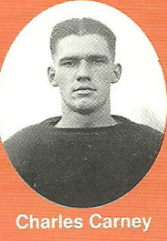Chuck Carney
 | |
| Illinois Fighting Illini | |
|---|---|
| Position | End |
| Career history | |
| College | Illinois (1920–1922) |
| Personal information | |
| Born: |
August 25, 1900 Chicago, Illinois |
| Died: |
September 5, 1984 (aged 84) Manchester, New Hampshire |
| Career highlights and awards | |
| |
| College Football Hall of Fame (1966) | |
Charles "Chuck" Carney (August 25, 1900 – September 5, 1984) was an American football and basketball player.
Carney was born in Chicago in 1900. He enrolled at the University of Illinois where he excelled in both football and basketball. He played at the end position for the Fighting Illini football team from 1918 to 1921. He was selected as a consensus first-team All-American in 1920.[1] He was elected to the College Football Hall of Fame in 1966.[2]
Carney was a member of the Illini men's basketball team from 1920 to 1922. He established the single-season, Big Ten Conference record with 60 field goals during the 1921 Big Ten season.[3] He was selected as All-American basketball player in both 1920 and 1922,[4] becoming the first Big Ten athete to receive All-American honors in both football and basketball. He was named Helms Foundation College Basketball Player of the Year in 1922. He was posthumously honored in 2005 by being chosen for the Illinois All-Century basketball team.
After completing his studies at the University of Illinois, Carney served as an assistant football coach for several years. He held posts as the ends coach for the Northwestern Wildcats, Wisconsin Badgers, and Harvard Crimson. He later worked as a New York Stock Exchange representative for the investment banking and financial services firm of Dominick & Dominick.[2]
References
- ↑ "2014 NCAA Football Records: Consensus All-America Selections" (PDF). National Collegiate Athletic Association (NCAA). 2014. p. 5. Retrieved August 16, 2014.
- 1 2 "Chuck Carney". National Football Foundation.
- ↑ "Hapac Bulks Large In Basketball Book". Toledo Blade. March 8, 1940.
- ↑ "NCAA All-America Teams 1919-20 to 1998-99". the Association for Professional Basketball Research. Retrieved February 25, 2015.